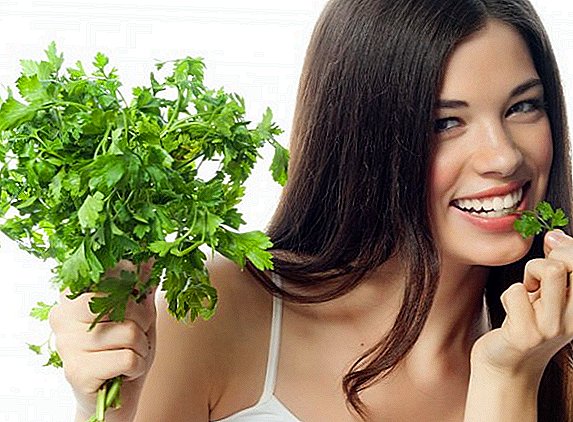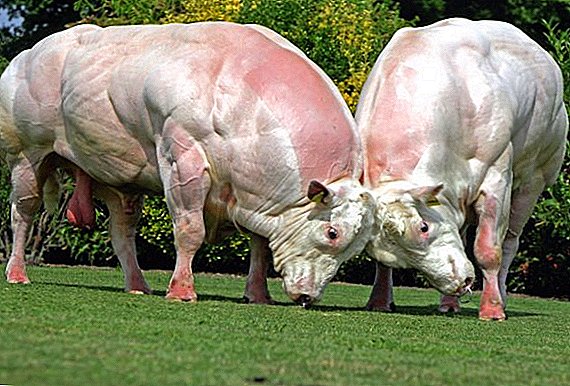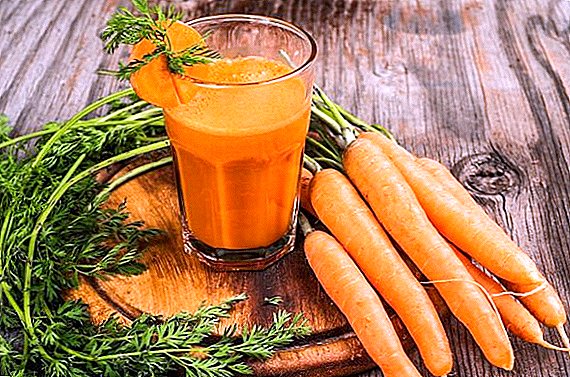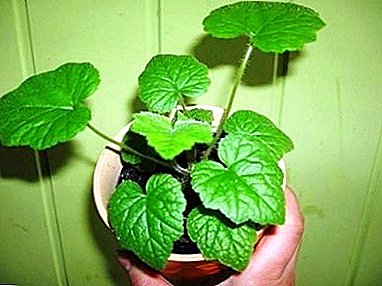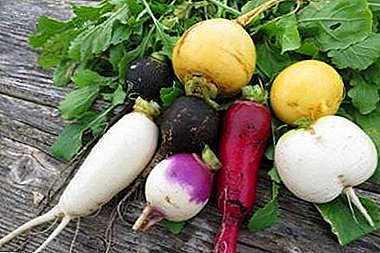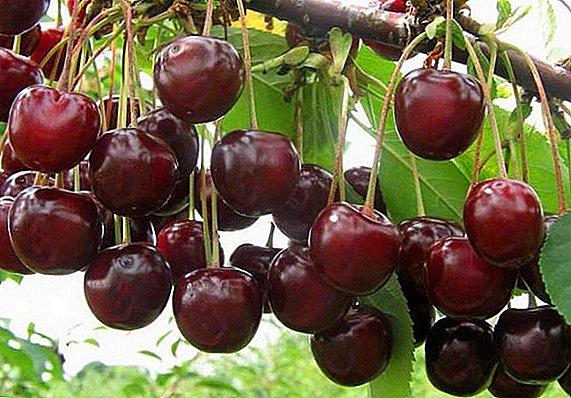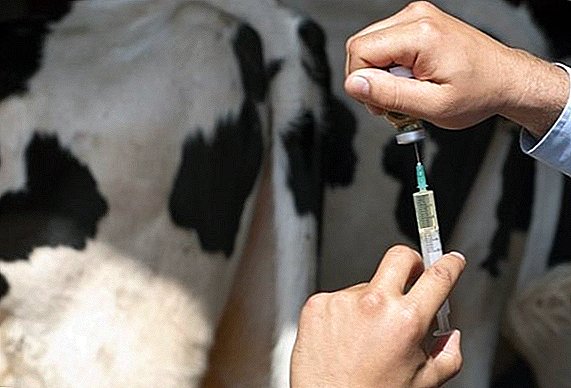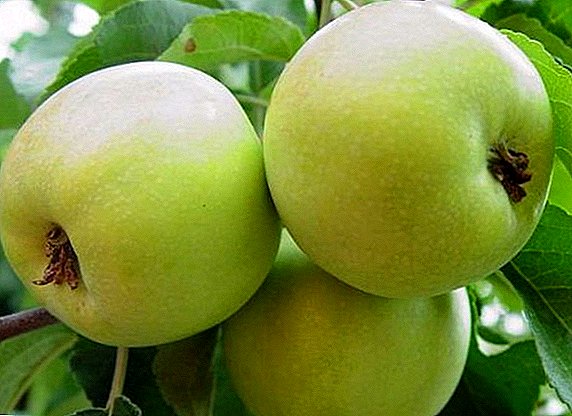 Dwarf apple varieties have always attracted the attention of gardeners, because with relatively small trees you can harvest a bountiful harvest. One of the best representatives of this type is the variety "Bratchud", characterized by tasty and juicy fruits, for which you do not have to spend too much energy. How to grow good and strong trees and what you need to know about further care for them - you will know in a few minutes.
Dwarf apple varieties have always attracted the attention of gardeners, because with relatively small trees you can harvest a bountiful harvest. One of the best representatives of this type is the variety "Bratchud", characterized by tasty and juicy fruits, for which you do not have to spend too much energy. How to grow good and strong trees and what you need to know about further care for them - you will know in a few minutes.
Breeding history
The full and original version of the name of the variety - "Brother of the Wonderful", and the abbreviation "Bratchud" appeared a little later.  In any case, both names denote dwarf apple trees of the winter ripening period, which were bred by the breeders of the South Ural Research Institute for Fruit-Growing and Potato-growing in the city of Chelyabinsk.
In any case, both names denote dwarf apple trees of the winter ripening period, which were bred by the breeders of the South Ural Research Institute for Fruit-Growing and Potato-growing in the city of Chelyabinsk.
The “parents” of the new variety are the hybrid Vydubetskoy weeping apple and the rather complicated form of the Ural Winter hybrid. Apple "Bratchud" appeared thanks to the efforts of researchers such as Mazunin N. A., Mazunina N. F. and Putiatin V. I.
In 2002, the variety was successfully zoned.
Check out such varieties of apple trees as Red Chif, Glory to the Victors, Royalties, Rozhdestvenskoe, Ural Bulk, Krasa Sverdlovsk, Orlinka, Orlovim, Zvezdochka, Kandil Orlovsky "," Papirovka "," Screen "," Antey "," Antonovka "," Uralets "," President "," Champion ".Despite the fact that the first samples landed in the areas of the Southern Urals and Siberia, they later turned out to be an excellent option for disembarking in other parts of the Russian Federation, in particular, in different areas of the Altai Territory and areas of the northwestern European part.
 The tree tolerates frosty winters when the temperature drops to -40 ° C.
The tree tolerates frosty winters when the temperature drops to -40 ° C.Key Features and Features
One of the advantages of this apple variety is the possibility of their long-term winter storage.
The description of "Bratchud" refers to 140 days of their guaranteed preservation, but only if you immediately after harvest, put the apples in wooden boxes with holes and place them in the basement, where the average temperature is kept at + 10 ... + 15 ° C.
Did you know? Holding apples afloat due to the presence in them of 20-25% of the air of the total mass.Another feature of the variety, expressed in the requirements for storage conditions, is the intolerance of close proximity to potatoes, so it is worth placing the boxes with cultures in different parts of the basement.
Now let us pay attention to the external features of the trees themselves and their fruits. 
Trees
The variety "Bratchuda" is also called "natural dwarfs", with a flat-round crown with a diameter of 2.5-3 m and a height of 2 m (if we are talking about a tree on clonal rootstocks). When using a seed stock, you can grow apples and up to 2.7 m tall.
The color of the bark on the main shoots and shtambe is dark brown, although depending on the growing conditions of the tree it sometimes has a darker or lighter shade. Fruiting is distributed across all fruit branches, including last year's growth.
The young shoots are medium thick, have a greenish-brown color and are distinguished by relatively fast growth rates. Oblong-rounded leaves are large, dark green in color, and slight pubescence is clearly visible on the upper part of the leaf plates.  The edges of the leaves have a large-crested serration.
The edges of the leaves have a large-crested serration.
Fruit
Bratchud apples are medium in size, slightly elongated and can be ribbed, although the main distinguishing feature of such fruits is the presence of a characteristic side seam, in the form of flat ones.
The outer surface of the apples is smooth, dry, with a slight glossy sheen and the complete absence of the usual wax coating. Peel is relatively thin.
The color of the fruit of the variety is greenish-yellow, although almost the entire peel of the apple is covered with a diffuse reddish-purple blush. Thick stalk is not very long and placed at right angles.  In fully ripe apples, the pulp has a white color, while in unripe it gives off a green tint. The consistency of the middle of the apple is coarse-grained, not too juicy, sweet-sour to the taste.
In fully ripe apples, the pulp has a white color, while in unripe it gives off a green tint. The consistency of the middle of the apple is coarse-grained, not too juicy, sweet-sour to the taste.
Carefully looking at the chemical composition of the fruit of apple "Bratchud", it is easy to see that they have a whole set of useful components: the sum of sugars, titrated acids, ascorbic acid, pectins, soluble solids.
Apples are great for fresh consumption and for processing into kissel, compotes, juices, etc.
Did you know? The longest apple peel that did not break during the cleaning reached a length of 52 meters and 51 cm, which is noted in the Guinness Book of Records. Katy Velfer from New York in 1976 peeled an apple for 11 hours and 30 minutes.The weight of one apple varies between 140-250 g, and about 120 kg of fruits can be collected from one tree. Regular annual fruiting can be expected already in the fourth year after planting.

Rules for the selection and purchase of seedlings
In addition to the general rules for the selection of seedlings (the selection of material without signs of disease, damage, etc.), in the case of dwarf varieties there are several other indicators of the quality of seedlings.
Of course, if you buy a young plant in a nursery, then there is no doubt that the Bratchud variety is in front of you, but if the choice of planting material is carried out in market or fair conditions, then you need to be doubly careful not to buy an apple tree instead of a dwarf sapling wow.
To exclude such an option, when inspecting the plant, pay attention to the space between the root neck and the stem of the seedling: there should be a well-marked knee-like protrusion on the dwarf rootstock, indicating vaccination.
A two-year-old sapling usually has at least four well-developed branches with large buds on them. For comparison, the dick can observe many sharp branches without a single bud.  The root system of a properly selected plant should be formed by a large number of small elastic roots, but rod-like roots should be avoided, since they indicate that you have a wild apple tree.
The root system of a properly selected plant should be formed by a large number of small elastic roots, but rod-like roots should be avoided, since they indicate that you have a wild apple tree.
Well, if the seedlings sold have certificates of quality - this will be additional evidence of the appropriateness of the purchase.
Choosing a place on the site
Before planting apple varieties "Bratchud" it is important to correctly determine the location of the future growth of the tree, because the abundance of the future harvest depends on this.
Like many other dwarf varieties, the described plant prefers elevated and well protected from the wind areas, located in the open sun or in light shade.  As for the soil, the most nutritious substrates are ideal, although good fruiting can also be achieved when planting in a sandy or clayey soil.
As for the soil, the most nutritious substrates are ideal, although good fruiting can also be achieved when planting in a sandy or clayey soil.
Preparatory work
The whole preparation can be divided into two stages: cleaning and processing of the selected area, and later inspection and treatment of the seedling before planting. We will understand the nuances of each of them more closely.
Site preparation
If you are planning a spring planting of apple seedlings of the Bratchud variety, then it is worth doing fertilizer and digging the soil in the selected area in the fall.
To begin with, it is necessary to remove all leaves and remaining plant parts from the selected area, and then dig up the soil and add some organic or mineral fertilizers to it (depending on the initial soil composition, the amount of manure used can be adjusted).  With the arrival of spring, about a month before planting, the square hole should be dug, 1.5 x 1.5 m in size (approximately the same depth), and put peat or humus on its bottom.
With the arrival of spring, about a month before planting, the square hole should be dug, 1.5 x 1.5 m in size (approximately the same depth), and put peat or humus on its bottom.
Important! Some gardeners recommend preparing a planting hole since autumn, so that the land will settle down well by the time spring arrives. However, their other colleagues insist on a comparative "freshness" of the seat, which supposedly will allow the seedling to settle down faster. It is difficult to say exactly which option is correct, therefore, it is possible to check the relevance of using each of them only on one’s own experience.To neighboring plants do not limit the growth of each other, between them leave at least three meters on all sides.
Seedlings preparation
In contrast to the preparation of the site, a similar process associated with the seedlings themselves, is performed immediately before the planting itself, about a day. You need to carefully examine the seedling (especially the root system) and determine its viability.
If the roots are dry, it is advisable to put them in water for 24 hours, although, of course, it would be better if after purchasing the planting material you immediately wrap its rhizome with a damp rag and land on your site as soon as possible.  The roots of a suitable seedling should be cut a little before planting in the soil, which will help to form the lower crown shtambur (the next time the growths are cut off after about a year).
The roots of a suitable seedling should be cut a little before planting in the soil, which will help to form the lower crown shtambur (the next time the growths are cut off after about a year).
Step-by-step process of planting seedlings
The best time for planting apple trees (and the Bratchud variety is not an exception) is considered to be spring, but this does not mean that you will not be able to plant the acquired seedlings, for example, in the fall.
True, you need to do this before the end of September and the beginning of October, so that before the onset of steady frost the plant has had time to settle down.
In the autumn, as soon as the trees begin to dive into a state of rest (usually this happens at the beginning or in the middle of October), you can start organizing the planting place and placing the seedling directly in it.
The upper twenty-centimeter layer of soil from the future pit should be folded to the side, then used to create a nutrient substrate, connecting with 2 buckets of humus (or peat) and adding 600 g of superphosphate and 700 g of wood ash.  After thorough mixing, the prepared substrate is poured back into the well, previously driven into the center of the count. As a result, you should have an earthen mound on which the seedling will be located.
After thorough mixing, the prepared substrate is poured back into the well, previously driven into the center of the count. As a result, you should have an earthen mound on which the seedling will be located.
At the same time, all the roots of a young plant must be carefully straightened, and then it remains only to cover the pit with the rest of the substrate.
The topmost layer of the mound will be the usual previously abandoned land from the top layer, without any fertilizer. Upon completion of work, the vaccination site should be located three centimeters above the ground level.
Important! The roots of a young plant should not directly interact with chemical or organic additives, as this may cause them to burn.After planting, the soil around young plants should be tamped, and departing 0.5 m from the trunk, create a cushion of 15 cm height from the ground.
 25-30 liters of water are poured into the near-stem circle, and once it is fully absorbed, the site can be mulched with humus or peat (not more than three centimeters in a layer), but so that they do not touch the trunk of the tree. The seedling itself must be tied up to a stake.
25-30 liters of water are poured into the near-stem circle, and once it is fully absorbed, the site can be mulched with humus or peat (not more than three centimeters in a layer), but so that they do not touch the trunk of the tree. The seedling itself must be tied up to a stake.Planting the Bratchud apple tree in the spring (the ground should already be thawed out, but the buds on the trees are still closed), all planting activities are carried out according to the above scenario, except that during the preparation of the pit it will not need to be fertilized in the fall.
Just hammer in a peg, pile in the soil and place a seedling on it, completing the procedure in the same way as in the first case.
For the convenience of harvesting and well-being of apple trees when planting a garden between adjacent plants should be left at least three meters, and between rows - about four meters of free space. 
Seasonal care features
After the planting of the apple of the variety "Brother wonderful" in front of you there will be another important task: to ensure proper seasonal care of the young tree.
This is not to say that this process is too different from similar actions when growing other apples, but you should not forget about the characteristic features.
Soil care
Before the beginning of the fruiting of a young plant, the seedling needs to be watered periodically, but no more than five times a year, pouring in five buckets of water at a time. As soon as the liquid is absorbed, the soil in the circle of the barrel needs to be fluffed, not allowing it to solidify.
In the process of loosening, which, by the way, can be carried out after the rains, it is useful to remove weeds from the ground, drowning the growth of a still fragile tree.  During especially hot periods and for the winter, the trunk circles are mulched, which helps prevent excessive evaporation of moisture and protects the root system from freezing. Peat, sawdust or even mowed grass is suitable for the role of mulch.
During especially hot periods and for the winter, the trunk circles are mulched, which helps prevent excessive evaporation of moisture and protects the root system from freezing. Peat, sawdust or even mowed grass is suitable for the role of mulch.
Top dressing
If you want to get abundant and high-quality yields of apples, then watering alone will not work. Any plant needs periodic supplements to get the nutrients for its growth and development.
In the case of the Bratchud variety, it will suffice to fertilize the soil with organic fertilizers 2-3 times per season: mullein extract, diluted in water in a ratio of 1:10 or infusion of chicken manure, but already mixed with water 1:20.
Organic fertilizing also includes straw, pigeon droppings, bone and fish meal, milk whey, potato peelings, egg shells, banana skins, tobacco dust, onion peel, nettle.Three years after planting, a solution of mineral fertilizers can be poured under each tree: for example, in the spring it can be nitrogen-containing or complex compounds.

Preventive treatment
Unfortunately, dwarf apple trees suffer from the same ailments and pests as their tall relatives, so there is nothing surprising in the fact that there are often scars on the trees of the Bratchud variety.
The spores of this disease are easily carried along with the wind, and if you look closely at the leaf plates, you will notice them: usually on the back of the sheet there are oily spots of light green color, which eventually turn brown-olive.
Important! If trees are not treated in time, the scab spreads quickly through the fruits, and they begin to crack, with the result that the entire crop can be irretrievably lost. Most often, such a disease attacks plants during rainy periods when it becomes damp outside.To prevent the development of the disease, it is necessary to perform periodic spraying of plants.
 With the arrival of spring, 3% Bordeaux liquid is used for this purpose, with repetition of the treatment at the budding stage. After harvesting, the tree is sprayed with 5% urea.
With the arrival of spring, 3% Bordeaux liquid is used for this purpose, with repetition of the treatment at the budding stage. After harvesting, the tree is sprayed with 5% urea.In addition, to protect your plantings from diseases and pests will help and autumn processing, which is carried out as soon as all the leaves fall from the apple trees. For spraying using a one-percent solution of Bordeaux mixture or "Nitrafen".
Pruning
For the dwarf "Bratchuda" pruning is needed not only for sanitary purposes, but also for even distribution of fruits and getting rid of weak shoots.
In addition to long withered or damaged branches, the same weak rootstocks are subject to removal, which allows a little thinning of the crown, but the main thing is not to leave completely empty spaces.  Gardeners recommend pruning the upper buds of an apple tree so that the middle ones can develop better. Formative pruning of dwarf apple trees is performed twice a year: in spring and autumn.
Gardeners recommend pruning the upper buds of an apple tree so that the middle ones can develop better. Formative pruning of dwarf apple trees is performed twice a year: in spring and autumn.
Important! Do not forget that all branches cannot grow equally, and among them there will always be strong and weak shoots, therefore your task is to control their growth and prune apple trees so that the strong branches are always below the weak ones and not ahead of the main parts.
Protection against cold and rodents
The root system of a dwarf apple "Bratchud" is very close to the surface of the soil, which means it can easily freeze in cold winters. Therefore, even despite the good winter hardiness of the variety, trees will have to be sheltered for the winter.
Before the cold weather itself (around mid-November), the apple trees are watered again, after which the mulching of the tree trunk is performed.  However, if your apple trees grow in areas with high groundwater deposition, then it is better not to conduct such a podzimny irrigation, immediately covering the near-barking circle with a thick layer of compost.
However, if your apple trees grow in areas with high groundwater deposition, then it is better not to conduct such a podzimny irrigation, immediately covering the near-barking circle with a thick layer of compost.
To protect plants from winter frosts and the ubiquitous rodents will have to wrap the tree trunks with one of the available materials: spruce branches, kraft paper or more expensive roofing material, roofing sheets or reed mats.
In addition, special plastic grids, which more reliably protect trees from the annoying attention of fluffy pests, do a good job with the task.
If all the rules for growing a dwarf apple tree are observed, the Bratchud variety will please you with a bountiful harvest of delicious apples, which can be safely kept until spring. That is, even in winter you will always have fresh fruit.



